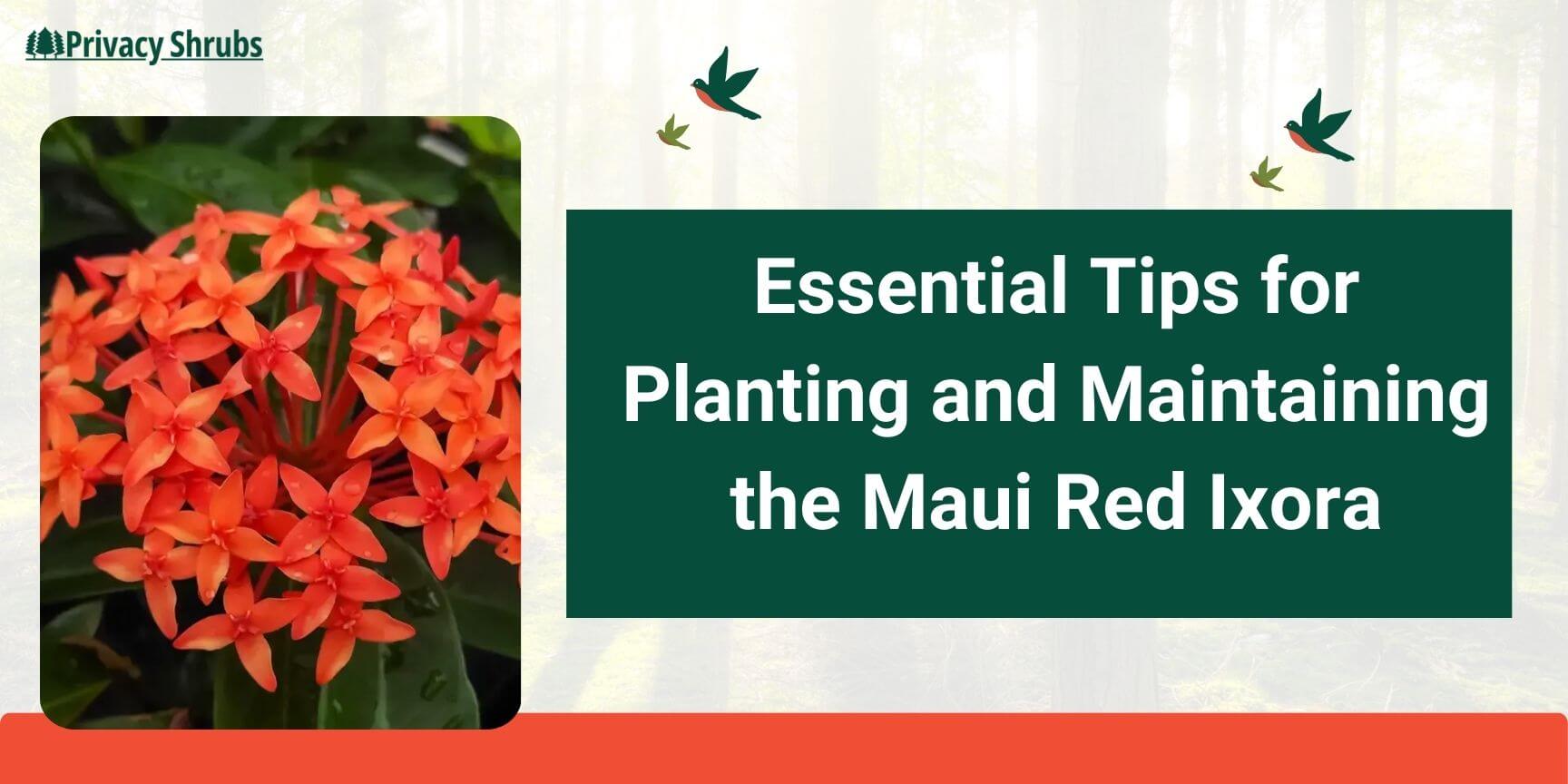The Maui Red Ixora (Ixora coccinea) is a lush, compact tropical shrub known for its vibrant clusters of red blooms that flower year-round.
Native to the tropical and subtropical regions of Asia, this plant has successfully adapted to similar climates across the globe, making it a popular choice in many tropical gardens, along with its white and orange varieties.
Our expert tips provide all the guidance you need to cultivate this stunning flowering plant. With the right care, it can become a true showstopper in your outdoor space.
This guide covers everything from its growth stages and suitable zones to proven strategies for tackling common challenges like pests and diseases.
Keep reading to learn about:
- Maui Red Ixora Plant Specifications
- Maui Red Ixora Growth and Developmental Stages
- Maui Red Ixora Growth Zone Information
- Best Growing Conditions for the Maui Red Ixora
- Watering Schedule and Other Essential Tips for Maintaining the Maui Red Ixora
- Must-Have Tools for Planting and Maintaining the Maui Red Ixora
- The Ultimate Guide to Planting the Maui Red Ixora from Propagation, Cutting, and the Seeds
- Taking Care of the Maui Red Ixora
- Common Issues with the Maui Red Ixora
- How to Choose the Best Maui Red Ixora Plant
- Conclusion
- FAQs on Successfully Planting and Maintaining the Maui Red Ixora Plant
Key Takeaways in This Maui Red Ixora Article
- The Ixora is a highly adaptable plant that can survive in any place, as long as the right conditions are met.
- As a tropical plant, it needs sunlight and a nutrient-rich soil.
- In colder regions, it. must be protected from frost and cold.
- Investing in tools to create the right environment is necessary. Humidifiers are an example.
- If planting indoors, keeping it in the kitchen and bathroom will mimic a more humid environment.
Maui Red Ixora Plant Specifications

The Maui Red Ixora is just one of many species in the Ixora family, with other popular varieties featuring yellow and white flowers.
Another well-known type is the Dwarf Ixora, which grows much shorter than the Maui Red. Among all the species, the Maui Red Ixora stands out as the most cold-tolerant.
However, this doesn’t mean it can handle frost or extremely cold conditions. As a tropical plant, it naturally thrives in sunny, warm environments.
| Attribute | Description |
|---|---|
| Botanical Name | Ixora coccinea |
| Common Names | Maui Red Ixora |
| Plant Type | Evergreen shrub |
| Mature Height | Up to 4 feet and above (1.2 meters) |
| Mature Spread | 3 to 4 feet (0.9 to 1.2 meters) |
| Leaf Color | Dark green, glossy |
| Leaf Shape | Elliptical to oblong, 2-4 inches long |
| Flower Color | Orangey-red |
| Flower Shape | Clustered in ball-shaped rose, round inflorescences (umbels) |
| Blooming Season | Year-round in tropical climates, peaks in spring and summer |
| Growth Rate | Slow to moderate |
| Light Requirements | Full sun to partial shade |
| Soil Requirements | Well-drained, acidic soil (pH 5.5 to 6.5) |
| Watering Needs | Requires regular watering. Keep the soil moist, but not soggy. |
| Temperature Range | Ideally 65°F to 75°F (18°C to 24°C), tolerates down to 30°F (USDA zones 10-11) |
| Humidity | Prefers high humidity |
| Fertilization | Balanced, slow-release fertilizer every 6-8 weeks during growing season |
| Pruning | Tolerates pruning, even severe trimming |
| Pests | Aphids, scale insects |
| Diseases | Fungal infections, leaf spot |
| Propagation | Stem cuttings, seeds |
Maui Red Ixora Growth and Developmental Stages
| Growth Stage | Description |
|---|---|
| Germination | The seeds germinate in 10-12 weeks. |
| Seedling | The young plants need bright light and regular watering. |
| Vegetative Growth | There’s noticeable growth with regular fertilization and pruning. |
| Flowering | There’s year-round blooming under optimal conditions like full sun and proper care. |
| Maturity | The plant reaches the full height of 6 ft feet (or taller if left unpruned) depending on care, maintenance, and growing conditions. |
Maui Red Ixora Growth Zone Information

This flowering plant thrives best in USDA hardiness zones 10-11 and requires full sun exposure—ideally 80-100% to reach its full potential.
In nurseries, however, these plants are often grown under shade cloth. Because of this, it’s important to gradually acclimate them to full sun over a week or two once you bring them home.
This gradual introduction helps prevent stress, which can otherwise negatively impact the plant’s health.
Best Growing Conditions for the Maui Red Ixora

Here are the light requirements and best placement tips for the the vibrant Ixora.
| Light Requirement | Placement Tips |
|---|---|
| Partial Shade to Full Sun | Plant in a location with partial shade to full sun. This plant is sun-loving and thrives with up to 80-100% sun. |
| Bright, Indirect Light | Place near a window with bright, indirect light when young or grown indoors. |
Sunlight
The this tropical shrub thrives in full sun. It requires at least 80-100% sunlight to blossom perfectly.
While it can tolerate partial shade, too much shade can lead to shedding leaves. As mentioned earlier, when you’re ready to transition from their shaded nursery environment to a brighter outdoor location, gradually do so over a week or two to prevent leaf burn.
Soil
The Ixora variety prefers well-draining, acidic soil with a pH level of 5.5 to 6.5. Rich, moist soil high in organic matter, such as compost or aged manure, is great for lowering the soil pH and adding nutrients.
You may also use a general slow-releasing fertilizer to add nutrients to the soil. Avoid planting Ixora in alkaline soils. Soil pH as high as 7 can lead to poor foliage color.
Watering Schedule and Other Essential Tips for Maintaining the Maui Red Ixora

| Watering Schedule | Watering Tips |
|---|---|
| Water regularly | Water the plant regularly, while allowing the soil to dry slightly between waterings |
| Avoid overwatering | Make sure you don’t get the soil soggy, as this plant doesn’t like waterlogged soil or zones. A waterlogged soil causes root rot |
| Check the soil moisture | Check soil moisture levels once in a while to ensure it’s not too dry or too wet |
Keep the soil evenly moist, but avoid making the soil soggy or waterlogged.
Water the soil deeply and regularly during the summer. Then, allow the soil to dry slightly between waterings.
In winter, reduce your watering frequency. Remember never to allow the soil to dry out completely.
Mulching around the base helps retain moisture and maintain even soil temperature.
Temperature and Humidity
This vibrant shrub greatly appreciates warm, humid environments. The ideal temperature is between 60-90°F (15-30°C).
In cooler climates, consider growing Ixora in containers, so they can be brought indoors during winter. While indoors, place the plant in places with high humidity, such as the bathroom or kitchen.
It’s good to invest in a small space humidifier to help create an optimum indoor environment for your this flowering plant to thrive.
Another useful tip is to spritz the plant with water daily. This is because high humidity levels above 50% are beneficial, especially when grown indoors.
Must-Have Tools for Planting and Maintaining the Maui Red Ixora

Get these tools ready to make your job easier, better, and faster.
Planting
| Task | Tools Needed |
|---|---|
| Soil Preparation | Garden fork, compost, soil pH tester, garden trowel |
| Planting Holes | Spade or shovel, measuring tape, gloves |
| Mulching | Mulch, wheelbarrow, garden rake |
Watering
| Task | Tools Needed |
|---|---|
| Regular Watering | Garden hose with a spray nozzle, watering can, and drip irrigation system |
| Deep Watering | Soaker hose, garden hose |
Watering
| Task | Tools Needed |
|---|---|
| Fertilizer Application | Balanced, slow-release fertilizer, fertilizer spreader, and watering can |
Pruning and Maintenance
| Task | Tools Needed |
|---|---|
| Pruning | Pruning shears, loppers, gloves |
| Weed Control | Hand weeder, garden hoe, mulch |
| Mulching | Mulch, wheelbarrow, garden rake |
Pest Control
| Task | Tools Needed |
|---|---|
| Organic Methods | Insecticidal soap, neem oil, spray bottle |
| Chemical Methods | Chemical insecticides, spray bottle |
The Ultimate Guide to Planting the Maui Red Ixora from Propagation, Cutting, and the Seeds

Planting: Plant your this tropical shrub in a well-drained location with full sun exposure.
For container planting, use pots that are 8-10 inches deep and wide for average plants. Make sure the pot has good drainage. Poor drainage leads to water-logged soil and consequently, root rot.
Avoid planting the the Ixora variety near concrete as the run-off from the concrete could increase the soil pH level, causing it to be alkaline, which isn’t a favorable soil condition for the plant.
Likewise, cement pots aren’t recommended. An acid-forming fertilizer can help counteract soil acidity.
Propagation: Ixora can be propagated from seeds or cuttings. You may need root hormones because rooting the this vibrant shrub can be difficult. Applying bottom heat can also be beneficial.
Occasionally, Ixora flowers produce dark purple berries. These contain seeds that are sometimes viable. When you spot these berries, harvest them and follow these instructions:
Clean and soak the seeds.
- Carefully extract the seeds from the berries.
- Clean the seeds: Rinse off any remaining pulp from the seeds to prevent mold and ensure better germination.
- Soak overnight: Place the cleaned seeds in a bowl of water and soak them overnight. This softens the seed coat, promoting quicker germination.
Step 2: Prepare the potting mix.
- Choose a pot: Select a 2-inch pot with good drainage.
- Fill with seed starter mix: Fill the pot with high-quality seed starter mix. This gives the right balance of nutrients and drainage for the seeds.
Step 3: Planting the seed.
- Plant the seed: Place the soaked seeds into the soil, covering them lightly with the soil.
- Water thoroughly: Water the soil well and make sure it’s evenly moist.
Step 4: Create a mini greenhouse.
- Cover with plastic bag: Loosely fasten a shade bag over the pot for a mini greenhouse effect. It maintains humidity and warmth around the seed.
- Place the pot in a warm area with moderate light. Avoid direct sunlight at this stage, as it can overheat the seeds. Then, gradually position them under bright light, removing the bag as the seeds germinate.
For cuttings:
- Take 4–6-inch cuttings from healthy plants in spring.
- Immediately trim the cutting below the leaves. Then, remove the lower leaves and dip the cut end in the rooting hormone.
- Plant in a pot with a well-draining potting mix containing equal parts peat moss and coarse sand or perlite.
- Enclose in a potting bag or propagating case, putting it under bright filtered light in a room with temperature levels between 21-27 degrees Celsius.
- When the cuttings have rooted nicely, uncover the bag gradually to make the plant adapt to its new less-humid environment. Do this over a 2-3-week period.
- Then, start watering it moderately, allowing a few centimeters (not up to an inch) of the potting mix to dry out before watering again.
- Afterward, move it into a new bigger pot 3 months after propagation. You can now treat it as a mature plant.
Taking Care of the Maui Red Ixora

The the Ixora species does well with some tender loving care. Even though the Maui Red Ixora isn’t a plant-it-and-go shrub, it’s not very demanding. Here’s a straightforward guide to helping its beauty reach its full potential.
Fertilization
This plant loves rich soil with lots of organic matter. So, add a layer of compost to the soil. You can also mulch the soil with pine needles or bark.
Avoid using cheap fertilizers to for your Ixora plant. Many of them contain too much salt that can harm the plant. Instead, use a balanced, slow-release fertilizer (10-10-10 or 20-20-20 ratio) thrice a year.
You can fertilize in March, May, and August. For each time, apply one tablespoon of fertilizer for every one foot of plant height.
Scatter the fertilizer around the plant on an area extending to the drip line. The drip line is the point where water drips from the outermost branches.
You can also feed the plant with one of the complete liquid foliar fertilizers every month from spring through fall. This plant is a heavy blooming plant and fertilizing this way will boost growth and flowering.
Ixora plants love liquid fertilizers that are high in nitrogen and potassium for healthy growth. During the growing phase, you can apply once weekly 10 inches away from the base to prevent root damage. Fertilizers with high nitrogen fertilizer are also helpful for your plant if you notice yellowing leaves.
Pruning
The Red Ixora takes pruning well because flowers bloom on new growth. You can prune each shoot down to one bud in late winter or early spring before new growth starts.
As you prune, remove dead, damaged, or diseased branches, and trim unruly growth to maintain the plant’s shape.
Branch trimming is preferable to being manicured with hedge trimmers. Pruning this way is a good care and maintenance practice that encourages denser growth and better flowering.
Common Issues with the Maui Red Ixora

Ixora plants can face several typical problems impacting their growth and appearance. Here are some of the most frequent ones and tips to address them:
Nutrient Deficiencies
| Issue | Details |
|---|---|
| Iron and Manganese Deficiencies | Ixora can suffer from these deficiencies, especially when the soil is too alkaline. Watch out for chlorotic new growth and purplish-red spots on older leaves. If you notice such, use an appropriate fertilizer and do some soil amendments to correct these issues. You can also use some chelated iron supplements. |
Pests
| Pest | Details |
|---|---|
| Aphids | Examine the plants frequently for signs of aphids. If you notice any pest attack, use insecticidal soap or neem oil to eliminate them. |
| Mealybugs | Examine plants for mealybugs. Then, apply insecticidal soap or neem oil to control them. Beneficial insects like lacewings can assist in managing mealybug populations. |
| Scale Insects | Check the plants for scale insects and treat them with insecticidal soap or neem oil. Encouraging the presence of predatory beetles can help keep scale insects in check. |
| Thrips | Look out for thrips and use insecticidal soap or neem oil to manage infestations. |
Diseases
| Disease | Details |
|---|---|
| Anthracnose | This fungal disease causes dark spots on leaves. |
| Leaf Spot | If you notice signs of purplish leaf spots, then it’s a sign of nutrient deficiencies. Some spots signal fungal infections, and you need to remove the affected leaves and spray the healthy parts with fungicides to protect them. |
| Root Rot | Root rot will occur if your drainage is poor or if you overwater the plant. |
How to Choose the Best Maui Red Ixora Plant
When selecting a Maui Red Ixora, look for plants that appear strong and healthy, with multiple sturdy branches to support abundant blooms.
Although this shrub is relatively low-maintenance, it’s important to be mindful when buying. Avoid plants that show signs of sooty mold, as this often indicates the presence of aphids or scale insects.
To avoid disappointment, always purchase from reputable sources. Buying from trusted sellers drastically reduces the risk of ending up with a sick or dying plant—a situation that not only wastes money but also dashes your hopes and expectations.
At PrivacyShrubs.com, we pride ourselves on offering only the highest quality Maui Red Ixora plants. Whether for a cozy garden, a welcoming walkway, or any landscape, our carefully curated selection ensures you’ll find the perfect addition to your outdoor space.
Bring Home the Beauty of the Maui Red Ixora
Shop now and add a touch of tropical elegance to your garden.
Maui Red Ixora

$78.95
$104.99
Maui Red Ixora: A Lush, Red-Hot Addition to Your Landscape The Maui Red Ixora is a year-round flowering shrub with fiery red blooms that will transform your yard into a vibrant oasis. This low-maintenance shrub thrives in warmer climates and… View Product
Conclusion
The Maui Red Ixora is undeniably a hassle-free high-pay-off plant. Hard to ask for more, honestly.
If you give your Ixora the care it needs, it will reward you with flames of red that will transform your outdoor area in a glorious way.
This ultimate guide has covered everything you need to know about planting, growing, caring for, and maintaining the health of your Maui Red Ixora.
With tender loving care, this plant will make a striking difference in your environment, driveway, or patio.
Simply give it what it needs and it will reward you. In this case, that means sunlight, water, and nutrients.
Then, regular care, such as pruning and monitoring for pests, will keep it healthy and vibrant for the whole year. Don’t wait any longer and add the Maui Red Ixora to your garden now.
FAQs on Successfully Planting and Maintaining the Maui Red Ixora Plant
- What is the Maui Red Ixora?
- The this vibrant shrub is a tropical beauty. Its vibrant red flowers and glossy leaves that look and feel leathery to the touch are no ordinary. It’s often preferred as a hedge or accent plant in gardens, pathways, and landscapes.
- Can the Maui Red Ixora be grown indoors?
- Absolutely, you can grow the the Ixora species indoors. However, make sure you give it enough light and humidity by placing it in places with these conditions. This could be your kitchen or bathroom. A small humidifier is also a worthy investment.
- How often should I water the Maui Red Ixora?
- Water the plant regularly to keep the soil moist. Then, allow it to dry slightly between waterings.
- When is the best time to plant the Maui Red Ixora?
- The best time to plant is during the spring or early summer. During these seasons, the soil is warm and the plant has time to establish before the cooler months.
- What type of soil is ideal for planting the Maui Red Ixora?
- They grow very well in well-draining, rich, acidic soil with a pH level between 5.5 and 6.5.
- How much space should I leave between each plant?
- Space each plant about 2 to 3 feet apart to allow for adequate air circulation and growth.
- Can the Maui Red Ixora be grown in containers?
- Yes, they can be grown in containers. The pot should have good drainage and a high-quality, acidic potting mix should be used.
- What are the light requirements for the Maui Red Ixora?
- They love full sun, but can also grow in partial shade.
- How often should I water the Maui Red Ixora?
- Water regularly to keep the soil moist, but don’t let the soil get soggy. Increase the watering frequency when the climate is hot and dry.
- Does the Maui Red Ixora need any special fertilizer?
- If your soil is nutrient-rich, then there’s no special need for fertilizers. But then, organic compost or mulch will do wonders for this plant. If the leaves begin to look yellowish, add a high-nitrogen fertilizer to the soil.
- How can I encourage more blooms on my Maui Red Ixora?
- Give the plant sufficient sunlight. Deadhead spent flowers to encourage continuous blooming.
- Why are the leaves of my Maui Red Ixora turning yellow?
- Yellowing leaves can be a sign of overwatering, nutrient deficiency, or poor drainage. Check the soil moisture levels and make sure the plant isn’t sitting in waterlogged soil.
- What should I do if my Maui Red Ixora isn’t blooming?
- If your Ixora isn’t blooming, it may not be getting enough sunlight or nutrients. Put it in a location with adequate sunlight and provide regular feeding with a balanced fertilizer.














